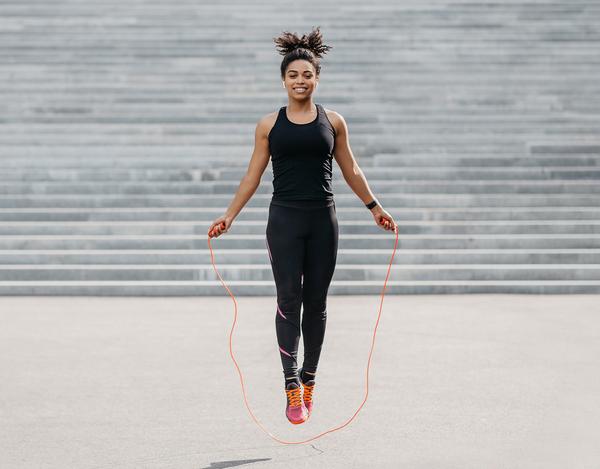



SELECTED
ISSUE
|
|
Leisure Management - Snackable workouts

Talking Point

|
|
| Snackable workouts
|

Another by-product of the pandemic, snackable workouts have become
a thing, but are they here to stay? Kath Hudson rounds up views
|

The snackable trend is seeing people breaking up their day with short workouts to avoid being sedentary Prostock-studio/shutterstock
|
|
|
Snackable workouts are named in HCM’s Fitness Foresight report as one of the top 20 trends for 2021, while research into the exercise habits of almost 20,000 Americans in the 50 largest US cities, via the Mindbody Wellness Index, also reflects the popularity of short workouts that can be squeezed into little pockets of time between Zoom meetings and homeschooling.
One of the by-products of the pandemic so far has been blurred work:life boundaries. As offices and schools shut their doors and everything was brought into the home, many people lost their daily routine and their usual windows for a workout. And when gyms reopened, workout slots were typically time limited to allow for additional cleaning time.
So will short workouts be an enduring trend? Do consumers just want online workouts to be bite-sized, or are they looking for group exercise classes in-club to be shorter too? We ask our panel of operators and suppliers what they’ve noticed and how they’re responding.
|
Michelle Dand
David Lloyd Clubs
 Snackable workouts are encouraging people to cross genres, says David Lloyd’s Michelle Dand / photo: DLL
We’ve seen a strong demand for snackable workouts over the past 15 months, sparked by the change in how members accessed their fitness content while our clubs were closed.
Snackable workouts are an incredibly smart way to train, as they fit into our busy lives and provide a good escape from working at home.
Our snackable content lives within our @home app which we launched at the start of lockdown one. One of our most popular classes was our 28-day ab challenge: 10 minutes a day across 28 days. Led by one of our experienced instructors and programmed to ensure progress, members loved how easy it was to fit into their days and how effective it was.
We also offer 20-minute HIIT and holistic sessions, which are incredibly popular, as they provide an effective workout which is easy to fit in before breakfast, or while the kids eat dinner. It’s the convenience of having a personal trainer in your pocket, available whenever it suits you.
However, I think the best thing about the snackable trend, is that it’s encouraging people to cross genres and do something different to complement their existing training. For example, cyclists are using our 10-minute Stretches for Cyclists session, and runners are using the Yoga for Runners programmes. These are people who typically wouldn’t cross genres in clubs and are generally not willing to switch out their regular Cyclone cycle class for a full-length Spirit class. The convenience of these shorter workouts enables them to get the benefit, without needing to commit to a full-length class in club.
Snackable workouts are an incredibly smart way to train
Hannah Curtis Nunn
Gymbox
 Curtis Nunn says members will learn the choreography for new class, Pixel Whip, at home before bringing it into the gym / photo: Gymbox
During lockdown we definitely saw an appetite for 30 minute classes online, as well as bite-sized classes, which teach skills and build progression over a few classes – for example Muay Thai moves, or how to do a handstand.
However, since we’ve been able to offer group exercise in the clubs again, people have definitely been keen to take part in longer classes. Members are hungry for the immersive class experience, with an instructor, lights, music, energy and the sense of community, which they missed out on while exercising at home. Our skills-based classes, which use equipment and expertise which people don’t have at home, have been especially popular, such as Olympic lifting and aerial classes.
We’re also noticing an appetite for outdoor workouts and we have a couple of partnerships to cater for this demand. For those who have caught the running bug, for example, we’re working with Track Mafia, to run classes which teach good form in order to remain injury free and build performance and then in partnership with Steel Warriors – which builds street gyms out of confiscated knives – we’ve been offering calisthenics and animal movement classes at three London sites.
What we’re noticing is that members are coming to the club two or three times a week for a long workout and are then supplementing this with shorter workouts at home, which they can fit in around their daily routine. We’re constantly working on ways to get our online and off-line offerings to complement each other. For example, with our new class, Pixel Whip, members can learn the choreographed moves online, so they know how to do it when they come to the club.
Members are hungry for the immersive class experience
 The classic 55-minute classes remain the most popular on Les Mills on Demand, says Franklin / photo: Les Mills
We’re yet to see the trend for snackable workouts among our users. In fact, we’re seeing a strong preference for the longer, comprehensive full-body workouts. Our most popular workouts on Les Mills on Demand (LMOD) remain our classic 55-minute classes.
Over the course of last month, the top 15 workout videos on LMOD were predominantly 45 to 55 minutes, with some 30 minute workouts too. Two of the top 30 minute workout videos were Les Mills Tone releases, which is a new offering, combining the optimal mix of strength, cardio and core training.
Typically, we find people who work out more frequently opt for longer workouts, while people who struggle to fit exercise into their days pick the shorter workouts when they’re able to exercise.
As the industry re-opens and workout habits continue to evolve, consumers want the flexibility of being able to work out when and where they want, be it at home, outside or in an exhilarating live class experience. Most typically it’s a combination of these, as the modern consumer expects a truly omnichannel fitness experience.
According to our 2020 customer satisfaction survey, 61 per cent of LMOD members in the UK also pay for a gym membership.
We find people who work out more frequently opt for longer workouts

Les Mills is not yet seeing a demand for snackable workouts / pixelheadphoto digitalskillet/shutterstock
Sunil Rajasekar
Mindbody
 “Snackable workouts are here to stay,” according to Mindbody president and CTO Sunil Rajasekar / photo: Mindbody
Mindbody predicts the trend for snackable workouts is here to stay. Our research shows nearly four in ten Americans work out for half an hour or less. Snackable workouts give people the opportunity to squeeze in a workout when they might not have otherwise been able to before. Shorter sessions are proving effective and convenient when wearing the many hats parents and professionals are asked to wear in these times.
Because snackable workouts require a smaller time investment, shorter sessions may also make virtual workouts more of interest for those reluctant to go digital. Consumers who aren’t taking advantage of virtual workouts say they’re boring (28 per cent) or that they get too easily distracted when they’re exercising at home (24 per cent).
Snackable workouts are ideal for those who are experiencing burnout at home, bringing quick and attainable movement and energy into the workday. We’ve seen many of our customer studios shift to offering a hybrid model as state lockdown restrictions are lifted, offering virtual programming alongside the in-studio classes.
Snackable workouts are ideal for those who are experiencing burnout at home
Tom Cowan
Exercise physiologist
 Snackable workouts can help people to meet the WHO weekly exercise target, says Tom Cowan /
Des Iles Photography
Half an hour should be short enough for many people to find the time to fit exercise into their schedule, allowing them to be active most days and meet the World Health Organization guidelines of completing at least 150 minutes of moderate intensity aerobic exercise a week.
Any form of cardiovascular exercise, such as cycling, swimming, jogging or brisk walking, lasting 10 minutes or more, counts towards this 150 minute a week goal. So the move towards exercise snacking makes it much easier for people to cram exercise into busy schedules, improve adherence and achieve their health and fitness goals. It’s also a good option for those suffering from conditions such as chronic fatigue.
A 2014 study showed that doing 12 minutes of high intensity exercise before each of the three main meals improved glycaemic control for individuals with insulin resistance and studies have shown significant reductions in blood glucose, as a result of increased glucose uptake into the muscles for up to 24 hours after HIIT.
However, although short HIIT workouts are popular and effective, it doesn’t have to be the case that a short workout is high intensity. Different types of exercise snacks could be used throughout the day to break up the amount of time spent being sedentary. Two short workouts a day, with rest time in between, can actually lead to achieving more in each session and more health benefits.
However, if people are opting for shorter workouts they do still need to have a well rounded exercise programme, incorporating resistance training, cardiovascular training and flexibility. It’s a good idea to have different exercise snacks at different times of the day, focusing on different components of fitness and different muscle groups, which can contribute towards the recommended 150 minutes of moderate-intensity aerobic exercise a week and strength exercises for all of the major muscle groups.
Different exercise snacks can be used throughout the day to break up time spent being sedentary
|
|
 |
| Originally published in Health Club Management 2021 issue 6
|
|
 |
|
